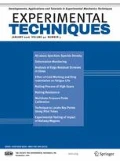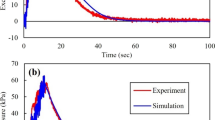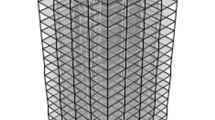Abstract
Widely used in earthquake engineering, Hybrid testing is promoted in various domains such as wind engineering, coastal structures and fluid-structure interaction. It also begins to be applied to fire engineering (Hybrid Fire Testing or HFT) for coupling fire tests and numerical simulations. However, HFT is still in its infancy. Yet, some tests have been performed and some algorithms have been developed. Recently, Mergny et al. [1] proposed a framework based on linear control system theory for a displacement control procedure. It uses proportional integral (PI) controller and allows performing HFT with non-linear substructures. The method was validated numerically but no analysis was provided about stability. This paper aims to describe the effects on stability of the main sources of errors in the case of HFT using PI control, namely delays, experimental errors and estimation of the stiffness of the physical substructure that is essential for most of the methodologies that have been developed so far. The research shows first through the equations of a single degree of freedom (SDOF) system that the estimation of the stiffness is a potential source of instability and affects directly the design of the PI controller. A simplified model for MDOF system was developed. Then, the research highlights that the effect of the experimental errors can involve a modification of the apparent mechanical response of the specimen and causes instability. However, this effect can be greatly limited. Finally, the delay is not a source of instability. A virtual hybrid test is performed in a steel frame and shows that the simplified model is a satisfying approximation and that described effects of the estimation of the stiffness established for a SDOF system can be observed for a complex system.









Similar content being viewed by others
References
Mergny E, Drion G, Gernay T, Franssen JM (2019) Hybrid fire testing in a non-linear environment using a proportional integral controller. Journal of Structural Fire Engineering. https://doi.org/10.1108/JSFE-09-2018-0022
Hakuno M, Shidawara M, Hara T (1969) Dynamic destructive test of a cantilever beam Controlled by an Analog-computer. Trans. Japan Soc. Civ. Eng. 171:1–9
Nakashima M, Kato H, Takaoka E (1992) Development of real-time pseudo dynamic testing. Earthquake Engineering & Structural Dynamics, 1992. 21(1):79–92
McCrum DP, Williams MS (2016) An overview of seismic hybrid testing of engineering structures. Engineering Structures 118:240–261
Lennon T (2003) Whole building behaviour – results from a series of large-scale tests, CIB CTBUH International Conference on Tall Buildings, 8–10 May 2003
Korzen M, Magonette G, Buchet P (1999) Mechanical Loading of columns in Fire Tests by Means of the Substructuring Method. Zeitschrift für Angewandte Math. und Mech. 79:S617–S618
Robert F, Rimlinger S, Collignon C (2010) Structure fire resistance: a joint approach between modelling and full-scale testing (substructuring system), 3rd fib International Congress
Mostafaei H (2013) Hybrid fire testing for assessing performance of structures in fire –Application. Fire Safety Journal 56:30–38
Franssen JM, Gernay T (2017) Modeling structures in fire with SAFIR®: Theoretical background and capabilities. Journal of Structural Fire Engineering 8(3):300–323
Whyte CA, Mackie KR, Stojadinovici B (2016) Hybrid Simulation of Thermomechanical Structural Response, Journal of Structural Engineering, pp. 142(2)
Wang X, Kim R, Kwon O, Yeo I, Ahn J (2019) Continuous Real-Time Hybrid Simulation Method for Structures Subject to Fire. ASCE Journal of Structural Engineering 145(12):04019152. https://doi.org/10.1061/(ASCE)ST.1943-541X.0002436
Memari M, Wang X, Mahmoud H, Kwon O (2020) Response of a structure subjected to fire following an earthquake event. ASCE Journal of Structural Engineering 146(1):04019182. https://doi.org/10.1061/(ASCE)ST.1943-541X.0002466
Tondini N, Abbiati G, Possidente L, Stojadinovic B (2016) A Static Partitioned Solver for Hybrid Fire Testing, 9th International Conference on Structures in Fire, DEstech Publications inc.
Sauca A, Gernay T, Robert F, Tondini N, Franssen JM (2018) Hybrid fire testing: Discussion on stability and implementation of a new method in a virtual environment. Journal of Structural Fire Engineering. https://doi.org/10.1108/JSFE-01-2017-0017
Shing PB, Mahin SA (1983) Experimental error propagation in pseudodynamictesting, Report UCB/EERC-83/12. Earthquake Engineering Research Center, University of California, Berkeley, 1983.
Horiuchi T, Konno T (1996) Development of a real-time hybrid experimental system with actuator delay compensation, 11th World Conference on Earthquake. Engineering, Acapulco, Mexico
Åström J, Murray R (2008) Feedback Systems: An Introduction for Scientists and Engineers, Princeton University Press, 2nd edition, November 2008
Schellenberg AH, Mahin SA, Fenves GL (2009) Advanced implementation of Hybrid Simulation, PEER Report 2009/104. University of California, Berkeley
Mosqueda G, Stojadinovic B and Mahin SA, Implementation and accuracy of continuous hybrid simulation with geographically distributed substructures, in UCB/EERC 2005–02, Earthquake Engineering Research Center. University of California, Berkeley
BIPM, IEC, IFCC, ILAC, ISO, IUPAC, IUPAP and OIML, Guide to the Expression of Uncertainty in Measurement, JCGM 100:2008 (GUM 1995 with minor corrections).
Shing PB, Mahin SA (1987) Cumulative experimental errors in pseudodynamic tests. Earthquake Engineering & Structural Dynamics, 1987. 15(4):409–424
Sadek, F., Main, J. A., Lew, H. S., Robert, S. D., Chiarito, V. P., and El-Tawil, S. (2010), An Experimental and Computational Study of Steel Moment Connection under a Column Removal Scenario, NIST Technical Note 1669.
American Institute of Steel Construction. ANSI/AISC 360-16 Specification for structural steel buildings. AISC, 2016.
EN 1991-1-2:2009 – Eurocode 1: Actions on structures - Part 1-2: General actions - Actions on structures exposed to fire, 2009.
Sauca, A. (2016). Development and implementation of a methodology for hybrid fire testing applied to concrete structures with elastic boundary conditions, Ph. D. thesis, University of Liege, Liege.
Author information
Authors and Affiliations
Corresponding author
Additional information
Publisher’s Note
Springer Nature remains neutral with regard to jurisdictional claims in published maps and institutional affiliations.
Rights and permissions
About this article
Cite this article
Mergny, E., Drion, G. & Franssen, JM. Stability in Hybrid Fire Testing Using PI Control. Exp Tech 44, 687–699 (2020). https://doi.org/10.1007/s40799-020-00375-8
Received:
Accepted:
Published:
Issue Date:
DOI: https://doi.org/10.1007/s40799-020-00375-8




